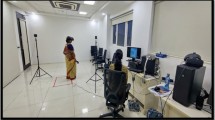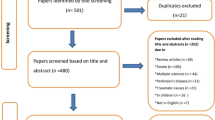Abstract
Previous experiences on vestibular compensation showed that multisensorial stimulations affect postural unbalance recovery. Virtual Environment (VE) exposure seems very useful in vestibular rehabilitation, since the experience gained during VE exposure is transferable to the real world. The rearrangement of the hierarchy of the postural cues was evaluated in 105 patients affected by visual, labyrinthic and somatosensory pathology in normal conditions and during sensorial deprivation. They were divided into five groups according to pathology and compared to 50 normal controls. Our data show that VE exposure is a reliable method to identify the deficient subsystem and the level of substitution. Moreover, Virtual Reality (VR) would accelerate the compensation of an acute loss of labyrinthine function, related to adaptive modifications of the vestibulo-ocular and vestibulo-spinal reflexes, overstimulating the residual labyrinthine function. The residual labyrinthine function is poor in chronic bilateral vestibular deficit and VE exposure should provide sensory substitution or sensory motor reorganisation, thereby modulating the external spatial reference and promoting the reorganisation of the multiple sensory input. The potential for VE exposure perspectives seems very promising when dealing with the vestibular system where there is a continuous rearrangement of different sensorial informations as a result of environmental and age-related changes.
Similar content being viewed by others
References
Cobb SV. Measurement of postural stability before and after immersion in a virtual environment. Appl. Ergon. Feb 1999; 30(1): 47–57
Kolasinski EM, Gilson RD. Ataxia following exposure to a virtual environment. Aviat Space Environ. Med. March 1999; 70(3 Pt 1): 264–269
Stanney KM, Hash P. Locus of user-initiated control in virtual environment: influences on cybersickness. Presence: Teleoperators and virtual environments, 1997
Reason JT. Motion sickness: a special case of sensory rearrangement. Advancement in Science 1970; 26; 386–393
Regan E, Price KR. The frequency of occurrence and severity of side effects of immersion virtual reality. Aviat. Space Environ. Med. 1994; 65: 527–530
Lackner JR, Graybiel A. Visual and postural motion aftereffects following parabolic flight. Avlat. Space Environ. Med. March 1980; 51(3): 230–233
Howarth PA, Finch M. The nauseogenicity of two methods of navigation within a virtual environment. Appl. Ergon. February 1999; 30(1): 39–45
Kennedy RS, Stanney JM, Ordy JM, Dunlap WP, Virtual reality effects produced by head-mounted display (HMD) on human eye-hand coordination, postural equilibrium, and symptoms of cybersickness. Society for Neuroscience, Abstracts 1997: 23: 772
Van Beers RJ, Sittig AC, Denier van der Gon JJ. How humans combine simultaneous proprioceptive and visual position information. Exp. Brain Res., September 1996; 111(2): 253–261
Hettinger LJ. Visually induced motion sickness in virtual environments. Presence: teleoperators and virtual environments 1992; 1: 306–307
Precht W. Recovery of some vestibulocular and vestibulospinal functions following unilateral labyrinthectomy. Prog. Brain Res. 1986; 64: 381
Di Zio P, Lackner JR. Spatial orientation, adaptation, and motion sickness in real and virtual environments. Presence: teleoperators and virtual environments 1992; 1: 323
Kennedy RS, Stanney KM. Postural instability induced by virtual reality exposure: development of certification protocol. International Journal of Human Computer Interaction 1996; 8(1): 2547
Rizzo AA, Buckwalter JG. Virtual reality and cognitive assessment and rehabilitation. The state of the art. In G. Riva, ed: Psycho-neuro-physiology assessment and rehabilitation in virtual environments: cognitive, clinical, and human factor in advanced human computer interaction, Amsterdam: IOS Press, 1997; 123–145
Norré ME. Habituation, sensory substitution and structural reorganization in vestibular compensation. In: Equilibrium disorders: brainstem and cerebellar pathology. Cesarani A, Alpini D, eds. Berlin: Springler Verlag, 1994; 199–204
Norrè ME. Relevance of function test in the diagnosis of vestibular disorders. Clin. Otolaryngol. 1994; 19: 433–440
Igarashi, Physical exercises and acceleration of vestibular compensation. In: Vestibular compensation, Lacour M, Toupet M, Denise P, Cristen Y, eds. Amsterdam: Elsevier, 1989; 101–105
Potvin AR, Sadoff M, Billingham J. Motion sickness and otholith sensitivity: a pilot study of habituation to linear acceleration. Aviat. Space Environ. Med. November 1977; 48(11): 1068–1075
Paulus W, Hawken M, Quintern J, Straube A, Krafczyk S, Botzel K, Brandt T. Multisensory versus monosensory stabilization of posture. Agressologie 1988; 29(10): 699–703
Edwards AS. Body sway and vision. J. Exp. Psychol. 1946; 36: 526–535
Brandt T. The relationship between retinal image slip, oscillopsia and postural imbalance. In: Functional basis of ocular motility disorders. Lennerstrand G; Zee DS, Keller EL, eds. Oxford, New York: Pergamon Press 1982; 379–385
Hu SQ, Stern RM, Koch KL. Effects of pre-exposure to a rotating optokinetic drum on adaptation to motion sickness. Aviat. Space Environ. Med. January 1991; 62(1): 53–6
Cooksey TE, Vestibular injuries. Proc. R. Soc. Med. 1945, 39: 270–273
Curthoys IS, Halmagyi MG, Vestibular compensation: a review of the oculomotor, neural, and clinical consequences of unilateral vestibular loss. Journal of Vestibular Research. 1995; 5(2): 67–107
Straube A, Paulus W, Quintern J, Brandt T. Visual ataxia induced by eye movements: posturographic measurements in normals and patients with ocular motor disorders. Clin. Vision Sci. 1989; 4: 107–113
Voorhes RL. The role of dynamic posturography in neurotologic diagnosis. Laryngoscope 1989; 99: 995–1001
Paulus W, Straube A, Brandt T. Visual postural performance after loss of somatosensory and vestibular function. J. Neurol. Neurosurg. Psychiat. 1987; 50: 1542–1545
Graybiel A, Lackner JR. Motion sickness: acquisition and retention of adaptation effects compared in three motion environments. Aviat. Space Environ. Med. April 1983; 54(4): 307–311
Peterka RJ, Benolken MS. Role of somatosensory and vestibular cues in attenuating visually induced human postural sway. Exp. Brain. Res. 1995; 105: 101–110
Kennedy RS, Fowlkes JE, Lilienthal MG. Postural and performance changes following exposure to flight simulators. Aviat. Space Environ. Med. October 1993; 64(10): 912–920
Fowlkes JE, Kennedy RS, Hettinger LJ, Harm DL. Aviat. Space Environ. Med. July 1993; 64(7): 612–618
Szturm T, Ireland DJ, Lessing-Turner M. Comparison of different exercise programs in the rehabilitation of patients with chronic perpheral vestibular disfunction. Journal of Vestibular Research 1994; 4(6): 461–479
Vitte E, Semont A, Berthoz A. Repeated optokinetic stimulation in conditions of active standing facilitates recovery from vestibular deficits. Exp. Brain Res. 1994; 102(1): 141–148
Bles W, Jong JMBV, de Wit G. Somatosensory compensation for loss of labyrinthine function. Acta Otolaryngol. (Stockh). 1984; 97: 213–221
Grant SC, Magee LE. Contribution of proprioception to navigation in virtual environments. Hum. Factors September 1998; 403(3): 489–497
Telian SA, Shepard NT. Update on vestibular rehabilitation therapy. Otolaryngol Clin. North Am. 1996; 29: 359–371
Shumway-Cook A, Horak FB. Rehabilitation strategies for patients with vestibular deficits. Neurol Clin. 1990; 8: 441–457
Horak FB, Jones-Rycewicz C, Black FO, Shumway-Cook A. Effects of vestibular rehabilitation on dizziness and imbalances. Otolaryngol Head and Neck Surg. 1992; 106: 175–180
Paulus W, Straube A, Brandt T. Visual stabilization of posture: physiological stimulus characteristics and clinical aspects. Brain 1984; 107: 1143–1163
Shepard NT, Telian SA, Smith-Wheelock M, Raj A. Vestibular and balance rehabilitation therapy. 1993; 102: 198–204
Herdman SJ. Role of vestibular adaptation in vestibular rehabilitation. Otolaryngol. Head and Neck Surg. 1998; 119: 49–54
Asai M. Effects of vestibular rehabilitation on postural control. Acta Otolaryngol. (Stockh). 1997 supp; 528: 116–120
Dieterich M, Brandt T. Impaired motion perception in congenital nystagmus and acquired ocular motor palsy. Clin. Vision Sci. 1987; 1: 337–345
Kuhlen T, Kraiss KF, Dohle C, Hefter H, Freund HJ. Virtual holography in diagnosis and therapy of sensorimotor disturbances. In: Health care in information age; Sieburg H, Weghorst S and Morgan K, Eds Amsterdam IOS Press 1996: 184–193.
Riva G. Virtual reality in neurosciences: a survey. In: Virtual environment in clinical psychology and neurosciences. Riva G, Wiederhold BK, Molinari E, eds. Amsterdam: IOS Press, 1998
Author information
Authors and Affiliations
Corresponding author
Rights and permissions
About this article
Cite this article
Di Girolamo, S., Di Nardo, W., Picciotti, P. et al. Virtual reality in vestibular assessment and rehabilitation. Virtual Reality 4, 169–183 (1999). https://doi.org/10.1007/BF01418153
Issue Date:
DOI: https://doi.org/10.1007/BF01418153




